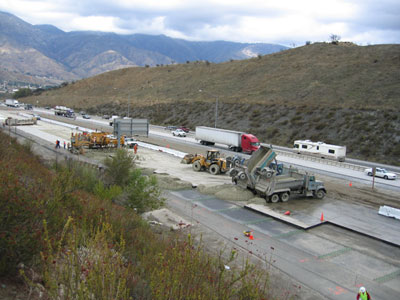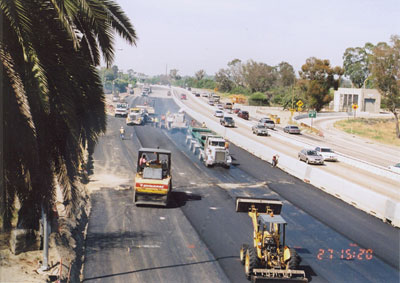U.S. Department of Transportation
Federal Highway Administration
1200 New Jersey Avenue, SE
Washington, DC 20590
202-366-4000
Focus
| Accelerating Infrastructure Innovations |
Publication Number: FHWA-HRT-09-007
Date: October 2008
Accelerated construction is increasingly a necessity for transportation departments across the country, as they balance rehabilitating and reconstructing existing highways with reducing congestion and user delays and improving safety. A new software tool, CA4PRS (Construction Analysis for Pavement Rehabilitation Strategies), now offers assistance in making accelerated construction a reality, making it easier for agencies to "Get in," "Get out," and "Stay out."
| "CA4PRS is designed to help highway planners and engineers select economical rehabilitation strategies while minimizing disruption to drivers and the surrounding community." |
"CA4PRS is designed to help highway planners and engineers select economical rehabilitation strategies while minimizing disruption to drivers and the surrounding community," says Jim Sorenson of the Federal Highway Administration's (FHWA) Office of Asset Management. The software was developed under an FHWA pooled fund study by the Institute of Transportation Studies at the University of California at Berkeley. California, Minnesota, Texas, and Washington State participated in the study.
FHWA has selected the CA4PRS software as a priority, market-ready technology ready for nationwide deployment. In support of this deployment, FHWA recently initiated changes through the pooled fund study (No. SPR-3(098)) to allow for licensing of the software by State transportation departments and to fund associated training and outreach on using the CA4PRS program and other construction analysis software tools (CAST). With these changes, all State highway agencies may now have access to the CA4PRS analysis tool and technical support at their request. The American Association of State Highway and Transportation Officials (AASHTO) Technology Implementation Group (TIG) is also promoting CAST, including CA4PRS, as part of its list of priority technologies.
CA4PRS can be used to identify optimal highway rehabilitation strategies that balance the construction schedule with inconvenience to drivers and transportation agency costs. The CA4PRS scheduling module estimates project duration, while its traffic module quantifies the impact of work zone lane closures on the traveling public. The cost module estimates total project cost (including construction, traffic handling, and supporting costs).
The program considers the "what if" scenarios for such variables as rehabilitation strategy; construction window (i.e., nighttime, weekend, or continuous closures); number of lanes to be closed for rehabilitation; material selection; pavement base type; and the contractor's logistics, including access to the site and production rates. The CA4PRS results can also be integrated with traffic simulation models to quantify the impact of a work zone on the whole highway network (including local arterials and neighboring freeways). The software aids in establishing schedules, developing construction staging plans, estimating cost plus schedule (i.e., A + B) contracts, and calculating incentive and disincentive specifications for contracts.
The California Department of Transportation (Caltrans) used CA4PRS to select the most economical rehabilitation scenario for a 4.5-km (2.8-mi) stretch of concrete pavement on I-15 in Devore. This eight-lane corridor has a high volume of weekday commuter traffic and an even higher average daily traffic of 120,000 on weekends, when drivers from Los Angeles use the corridor to travel to and from Las Vegas. The reconstruction project, which would have taken 10 months using traditional nighttime closures, was completed over two 9-day periods using the continuous closure of one roadbed and around-the-clock construction. The continuous closure resulted in a 25 percent reduction in agency costs for construction and traffic control, for a total savings of $6 million.
"We are continuing to use CA4PRS on selected projects and also continue to work on enhancing the capabilities of the software," says Michael Samadian, Pavement Research Branch Chief for Caltrans' Division of Research and Innovation. Planned enhancements over the next 3 to 4 years include adding modules for analyzing roadway widening and bridge replacement projects, as well as a life-cycle cost analysis module.
The Minnesota Department of Transportation has also used CA4PRS for resurfacing projects on I-494 and I-393, while the Washington State Department of Transportation has used it to analyze rapid rehabilitation strategies for two projects on I-5 in Seattle. Caltrans has conducted hands-on training workshops over the past 5 years for other States interested in using the software, including Florida, Michigan, Missouri, and Utah, as well as for those States participating in the pooled fund. "There has been very positive feedback to the training, with participants viewing the software as an applicable tool for their agencies," says E.B. Lee of the University of California at Berkeley's Institute of Transportation Studies.
FHWA and the AASHTO TIG will be launching additional activities over the next year to promote the use of CA4PRS and other CAST technologies, including identifying the successful use of construction analysis technologies around the country, developing case studies on various tools and methodologies and their resulting benefits, conducting Webinars, developing a CAST brochure that highlights tools currently available, and initiating FHWA and State peer exchange workshops. Focus will provide updates on CAST activities and resources as they are rolled out.
 |
 |
| Caltrans used CA4PRS to plan for the reconstruction of I-15 in Devore, CA (above), and I-710 in Long Beach, CA (below). |
For more information on obtaining a demonstration of CA4PRS, contact Ken Jacoby in FHWA's Office of Asset Management, 202-366-6503 (email: ken.jacoby@fhwa.dot.gov), or Michael Samadian at Caltrans, 916-324-2048 (email: michael_m_samadian@dot.ca.gov). More information on the software is also available at www.dot.ca.gov/research/roadway/ca4prs/index.htm.